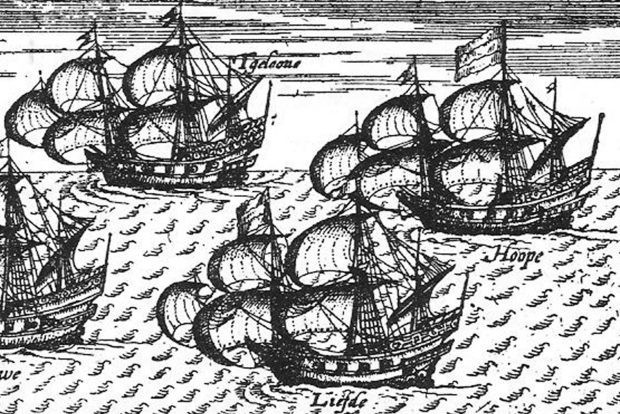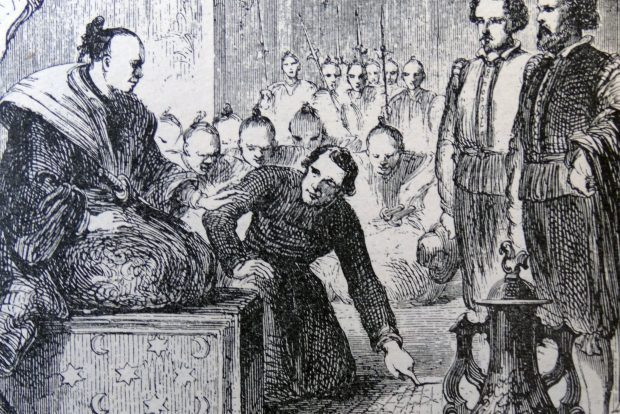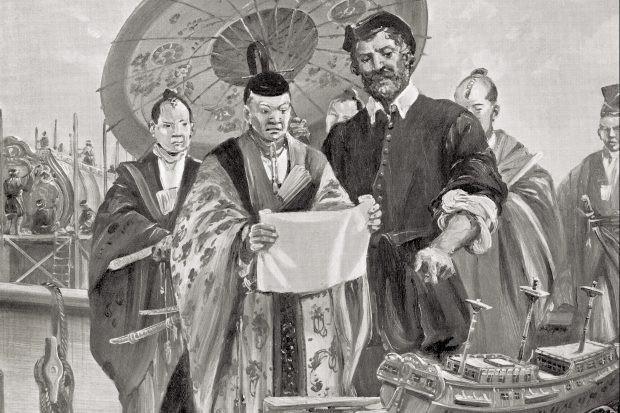The epic series Shōgun has captivated audiences with its portrayal of John Blackthorne, an English navigator who finds himself shipwrecked in 17th century Japan amidst political turmoil. Played by Cosmo Jarvis, Blackthorne’s journey is one of cultural immersion, strategic alliances, and samurai intrigue. But while Shōgun weaves a fictional narrative, the character of John Blackthorne is rooted in reality, inspired by a remarkable historical figure.
William Adams: The Real-Life Inspiration for John Blackthorne
 Cosmo Jarvis as John Blackthorne in FX's Shōgun, embodying the spirit of William Adams, the historical English navigator.
Cosmo Jarvis as John Blackthorne in FX's Shōgun, embodying the spirit of William Adams, the historical English navigator.
Cosmo Jarvis as English pilot John Blackthorne in FX’s Shōgun (Photo courtesy of Disney+)
John Blackthorne’s saga in Shōgun mirrors the extraordinary experiences of William Adams, the first Englishman to set foot in Japan. Adams wasn’t just a visitor; he became deeply embedded in Japanese society, even earning the prestigious title of samurai, albeit a non-warrior one. Just as Blackthorne forges a crucial bond with Lord Yoshii Toranaga in the series, Adams developed a close and influential relationship with Tokugawa Ieyasu, the historical figure who inspired Toranaga’s character.
Tokugawa Ieyasu, on the cusp of becoming shōgun, recognized Adams’s unique value. He relied on the English navigator for expertise in trade and diplomacy, a relationship that dramatically shaped early 17th-century Japan’s interaction with the West. Ieyasu bestowed upon Adams land, the honorable rank of hatamoto, and the symbolic katana swords of a samurai, acknowledging his esteemed position despite not being a fighter.
The Early Life and Voyages of William Adams
Born in Gillingham, Kent, in September 1564, William Adams’s early life remains somewhat shrouded in mystery. Our primary insights come from Adams’s own letter penned in 1611 from Hirado, Japan, addressed to his “Unknown friends and countrymen.” This letter reveals a formative apprenticeship beginning at age 12 under Nicholas Diggins in Limehouse, London. Here, Adams immersed himself in the essential maritime skills of nautical navigation, astronomy, and shipbuilding for twelve years, until he reached the age of 24 – coinciding with the year of the Spanish Armada in 1588.
Joining Sir Francis Drake’s navy during this pivotal year, Adams served aboard the supply ship Richard Duffylde. While his direct involvement in the naval battle against the Spanish Armada remains uncertain, this experience undoubtedly solidified his seafaring expertise. Following England’s victory and the disbandment of the fleet, Adams sought employment, spending a decade with the Barbary Company merchants before venturing towards Dutch fleets engaged in Asian trade.
It was through the Dutch that Adams’s path ultimately led him to Japan. The backdrop was the ongoing Dutch revolt against Spanish rule, further complicated when King Philip II of Spain inherited the Portuguese throne in 1581. This closed Lisbon, a crucial port for Asian goods, to Dutch merchants, compelling them to seek direct trade routes to Asia. The shared conflict with Spain fostered a natural alliance between Dutch and English sailors. In 1598, William Adams signed on as a pilot – then synonymous with navigator – aboard a Dutch fleet embarking on a voyage to the East Indies.
The Perilous Journey to Japan and Arrival on the Shores of Destiny
In 1598, five ships departed from Rotterdam, Dutch Republic, with ambitious plans. Their intended route involved navigating the treacherous Strait of Magellan, raiding Spanish ships and settlements in South America, and then trading these spoils for Asian goods to be brought back to Europe. However, of the five ships that set sail, only one, the Liefde, reached Japan in April 1600, carrying a drastically reduced crew of about twenty men, survivors of starvation, disease, and relentless hardships. William Adams was among these survivors.
Frederik Cryns, a leading expert on William Adams and historical consultant for FX’s Shōgun, explains the disastrous voyage: “They had a lot of problem with first the winds, so they couldn’t proceed on schedule. They didn’t have enough food, so a lot of the sailors starved. They had diseases and they had to fight the Portuguese, then they had to fight the Spanish. And when they came into South America, they were attacked by the native peoples living there.” Adams himself suffered a personal tragedy during these South American encounters – the loss of his brother, Thomas.
 Illustration depicting Dutch ships navigating perilous waters, highlighting the journey of the Liefde to Japan.
Illustration depicting Dutch ships navigating perilous waters, highlighting the journey of the Liefde to Japan.
The Liefde was the only one of the five ships in the Dutch fleet to reach Japan (Photo by Getty)
The Liefde‘s arrival in Japan was met with suspicion by local Japanese and hostility from Portuguese Jesuit missionaries. The Portuguese, who had until then enjoyed a monopoly on European interactions with Japan, immediately painted the Dutch crew as pirates, an accusation carrying a death sentence. However, news of the ship and its unusual crew reached Tokugawa Ieyasu, a powerful daimyo and one of the five regents governing Japan in the name of the young heir Toyotomi Hideyori. Ieyasu, known for his strategic mind and interest in new knowledge, decided to investigate further.
William Adams and Tokugawa Ieyasu: A Relationship Forged in Mutual Respect
Contrary to the dramatic events in Shōgun, William Adams did not directly influence Tokugawa Ieyasu’s ascent to shōgun. Historical accounts, as highlighted by Cryns’s book, In the Service of the Shōgun, reveal Adams’s limited involvement in the power struggles of that period. While Shōgun portrays Blackthorne as instrumental in Toranaga’s victory at the fictionalized Battle of Sekigahara, Adams was actually held in Osaka, imprisoned and interrogated by Ieyasu, during the lead up to the real Battle of Sekigahara in October 1600.
After initial imprisonment and questioning in Osaka, Adams was eventually released and relocated to Uraga, near Edo (present-day Tokyo), along with his ship and surviving crew. While prevented from repairing the Liefde and leaving Japan, he was otherwise left largely undisturbed. “He’s just sitting idle while Ieyasu fights his final battle against Ishida Mitsunari at Sekigahara,” Cryns clarifies. “It’s only after Ieyasu establishes his rule and everything stabilises that Adams is asked to join him.” It was after Ieyasu’s victory and consolidation of power that Adams’s unique skills and knowledge became invaluable.
Advisor, Shipbuilder, and Diplomat: Adams’s Influence on Japan
 William Adams being presented to Tokugawa Ieyasu, marking the beginning of a significant partnership that shaped Japan's international relations.
William Adams being presented to Tokugawa Ieyasu, marking the beginning of a significant partnership that shaped Japan's international relations.
William Adams is brought before Tokugawa Ieyasu. The Englishman would become one of the Japanese shōgun most trusted confidants (Photo by Getty)
While Adams didn’t teach Ieyasu to dive as depicted in some fictional accounts, his true impact lay in shaping Japan’s relationship with European powers and providing crucial counsel on international matters. Ieyasu, even after Sekigahara, still faced internal opposition until 1615. He also needed to break the Portuguese monopoly on foreign trade, particularly for essential goods like Chinese silks and lead for weaponry.
By 1603, Adams had moved to Edo and became a frequent consultant to Ieyasu. Recognizing the value of Western shipbuilding, Ieyasu tasked Adams with constructing a Western-style ship. Adams, with the help of Japanese craftsmen, successfully built an 80-tonne vessel, introducing Western shipbuilding techniques to Japan. Impressed by Adams’s capabilities, Ieyasu commissioned a second, larger 120-tonne ship and brought Adams into his inner circle. Adams became a tutor to Ieyasu, sharing his knowledge of mathematics, geometry, astronomy, and global politics.
 William Adams demonstrating ship designs to Tokugawa Ieyasu, showcasing his shipbuilding expertise that impressed the Shogun.
William Adams demonstrating ship designs to Tokugawa Ieyasu, showcasing his shipbuilding expertise that impressed the Shogun.
Englishman William Adams shows his ship designs to Japanese shōgun Tokugawa Ieyasu
Ieyasu bestowed further honors upon Adams, granting him an estate on the Miura peninsula, the prestigious title of hatamoto, and a significant income. Effectively, William Adams transformed into a minor lord within Japanese society. Crucially, Adams advocated for opening trade with the Dutch and English. Though forbidden from leaving Japan himself, he facilitated the arrival of the first Dutch vessel in 1609 and later played a key role in establishing an English trading factory in 1613 as Ieyasu’s official interpreter.
Perhaps Adams’s most impactful contribution was in 1611, with the arrival of the Spanish seeking trade on the condition that Ieyasu sever ties with the Dutch. Cryns explains Ieyasu’s dilemma: “That of course Ieyasu cannot allow. It’s totally contrary to his own policy,” However, Ieyasu permitted Spanish trade and missionary activities. When the Spanish requested to survey Edo Bay, ostensibly for anchorage, Adams vehemently cautioned Ieyasu, convinced it was a precursor to invasion.
Adams warned Ieyasu of the long-term threat posed by Spanish missionary activities, explaining, “…they send missionaries, they will make a lot of Christians in Japan, and then together they cooperate with those Christians to overthrow your government.” This warning had profound consequences, marking the beginning of the suppression of Christianity in Japan, culminating in the eventual isolationist policies that severely restricted foreign access, confining Portuguese and Dutch traders to Nagasaki. Adams’s advice profoundly shaped Japan’s future diplomatic trajectory.
Miura Anjin: The Japanese Name of William Adams
In Shōgun, John Blackthorne is called ‘Anjin’, the Japanese word for pilot or navigator, reflecting the locals’ difficulty in pronouncing his English name. Similarly, William Adams acquired the Japanese name ‘Miura Anjin’ after being granted his estate on the Miura peninsula – signifying “the pilot of Miura.”
The Final Chapter: William Adams’s Death and Legacy
William Adams passed away on May 16, 1620, four years after the death of Ieyasu. He left behind his English wife, Mary Hyn, and their children, as well as a Japanese wife and their two children in Japan, creating two distinct family lines. While the fictional Shōgun concludes with Blackthorne destined to remain in Japan, William Adams also never returned to England.
Despite being granted permission to leave Japan in 1613, Adams chose to stay. He entered the service of the British East India Company, navigating trading expeditions to Siam (Thailand) and Vietnam. Cryns suggests the reasons for his choice: “In Japan he was a small lord. He had a fief allotted to him by Ieyasu. He had households serving him… He was a man of influence in Japan. But if he went back to England, he was just another sailor.” William Adams, the real John Blackthorne, found a new life and lasting legacy in Japan, forever bridging two worlds.
Stream Shōgun on Disney+. Discover more about historical dramas with our recommendations for the best historical movies and history TV shows. Explore the latest in historical content with our weekly guide to history TV and radio in the UK.
Learn more from Frederik Cryns, Professor of Japanese History, in his book In the Service of the Shogun: The Real Story of William Adams, available from Reaktion Books in May 2024.
